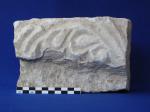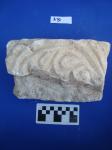Illustrations
- No uploaded files
Description
- Medieval low relief
- White marble
- 1
- 18.0
- 10.5
- 11.5
- The piece was trimmed into a roughly rectangular block. Chisel marks are readily apparent on the back of the block. The lower half of the face carved in low relief is cut about 2 or 3 cm deep. Traces of mortar suggest that this fragment was reused as construction material.
- The front face of the block preserves a highly stylized curved acanthus leaf carved in low relief. The leaf bends into a semi-circular arc, the top of which has been cut off; three tear-shaped fronds emerge from the interior curve.
- This motif can be counted among the stock patterns of the period. Rudolph Kautzsch (1939, 17–9) noted its early (eighth-century) appearance in the north, in the vicinity of Milan, and provided a number of examples and variations including S. Prassede (817–24), S. Maria in Trastevere (now in the portico) and a fragment from the Cathedral of Anangi (now attached to the façade) (Kautzsch 1939, 17–8, figs 29–31; for the S. Prassede piece see also Pani Ermini 1974, no. 61). Nearby examples can be found in cathedral of SS. Giovanni and Paolo, Ferentino (Ramieri 1983, nos 38 and 40). The pattern was applied to all kinds of liturgical furnishings. It enlivens one side of a ninth-century well head from Murano, Italy now housed in the V&A, London (no. 54-1882, http://collections.vam.ac.uk/item/O107425/well-head-unknown/); and the side of a
Record Details
-
VM_2079
- strato di macerie al di sotto do 2027

![Download [view]](/villamagna/ark//skins/villamagna/images/results/download_sml.png)
